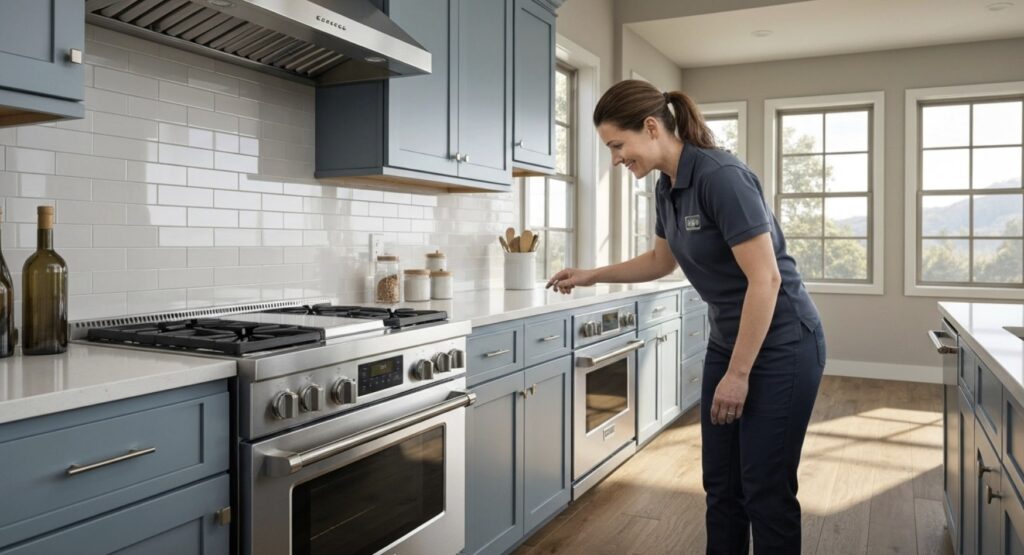A wine cooler is an important appliance for wine lovers. It keeps their favorite wines safe. But a broken thermostat can make this safe place a risky one. It can harm the taste and quality of your wines. This clear guide will help you in replacing a faulty wine cooler thermostat. With this guide, you can get your wine cooler working well again.
Signs of a Faulty Thermostat
A broken thermostat can show up in different ways. Each issue can hurt the temperature inside your wine cooler. If you notice these signs early, you can keep your wine safe and protect your appliance.
One clear sign is when the temperature inside the cooler keeps changing a lot. This can happen even if you do not change the thermostat setting. You may also see wrong temperature readings on the display when you check with another thermometer. If the thermostat controls stop working or if the compressor does not turn off and keeps running without reaching the set temperature, it means the thermostat is likely not working right and needs fixing.
Preparing for Replacement: What You Need
Before you start replacing the thermostat, it is important to gather the tools and materials you need. This helps make the process easy and successful. Having everything ready lets you work safely and avoids delays.
Getting the right equipment from the beginning means you can focus on getting the job done. Let’s look at the key items that will help you in this task.
Tools and Materials for the Job
- Tools:
- Phillips and flathead screwdrivers (different sizes)
- Needle-nose pliers
- Multimeter
- Flashlight
- Materials:
- Replacement thermostat (works with your wine cooler model)
- Wine cooler owner’s manual
- Small container or tray (to hold screws)
- Work gloves
Having different sizes of screwdrivers helps you work with various screw types found in appliances. Needle-nose pliers are very useful for handling wires in tight spots, giving you control and precision. A multimeter checks the old thermostat to see if it works and makes sure the new one does too.
A flashlight lights up your workspace, especially inside the cooler where it can be dark. The owner’s manual is a helpful guide, giving specific instructions and diagrams for your model. Lastly, a small container keeps screws organized and stops them from rolling away, while work gloves help protect your hands and give you a better grip.
Safety Precautions Before Starting
Before starting the replacement process, safety is very important when you work with any electrical appliance. If you ignore these safety tips, you might face hazards like electrical shocks.
The first step is to unplug the wine cooler from the outlet. This stops any electrical current from going through the cooler while you work. For extra safety, you can turn off the circuit breaker or take out the fuse that controls this outlet.
Make sure to check the manufacturer’s instructions for your specific wine cooler model. These instructions may include warnings about working with refrigerant lines or steps to access the internal parts. Remember, being careful will help you have a safe and successful repair.
Step-by-Step Guide to Replacing the Malfunctioning Thermostat
With safety measures set and tools prepared, you are ready to replace your thermostat. This simple guide will help you through every step. It will make things clear and boost your confidence.
If you follow these steps closely, you can get your wine cooler back to the right temperature. This will keep your wine collection safe. Let’s start fixing your appliance.
Step 1: Accessing the Thermostat
- First, make sure the wine cooler is unplugged and that the power source is turned off.
- Then, open the door of the cooler and take out all the wine bottles and shelves. This will help avoid any damage or blocking while you work.
- The thermostat is usually found on the back wall inside the unit. Depending on your wine cooler model, you may have to take off some extra panels to reach it. Check your owner’s manual for help with finding and accessing the thermostat.
- When you find the thermostat, take clear pictures or draw a diagram of the wire connections. This is very important. It will help you connect the wires correctly to the new thermostat later. You can label the wires if you need to.
Step 2: Testing the Existing Thermostat
Before taking out the old thermostat, it is smart to test it with a multimeter. This helps make sure it is faulty and rules out other issues that might be causing temperature problems.
Set your multimeter to the “Ohms” or resistance setting. Place one probe on each terminal of the thermostat. A reading of zero ohms shows that the thermostat is working well.
If the multimeter shows no reading or infinite resistance, that means the thermostat is faulty and must be replaced. If the test shows the thermostat is faulty, move on to the next step to remove it.
Step 3: Removing the Old Thermostat
With the broken thermostat found, you can now take the wires off its terminals. Look at your pictures or the diagram from Step 1 to help you remember where each wire goes. If you tagged the wires, this job will be even easier.
After you disconnect the wires, use the right screwdriver to take out the screws that hold the thermostat. Carefully pull the old thermostat away from its mount. Be careful not to hurt any nearby parts while doing this.
After the old thermostat is off, take some time to clean the place where it was mounted. Get rid of any dust, debris, or sticky stuff to have a clean area for the new thermostat.
Step 4: Installing the New Thermostat
- Carefully place the new thermostat on the bracket or holes inside the wine cooler. Make sure it is level and in the same spot as the old thermostat.
- Secure the new thermostat using the screws you took out earlier or the ones that came with the replacement.
- Next, reconnect the wires. Look at the photos or diagram you took when you took things apart. Connect each wire to the right spot on the new thermostat. It is important to have tight and secure connections for it to work well.
- After you connect the wires, give them a gentle pull to check that they are still secure. Loose connections can cause problems. Review your notes to ensure all connections are correct before moving on.
Post-Replacement Checks and Maintenance
After you install the new thermostat, it is time to check if everything is working right. You should also start some easy maintenance to keep your wine fridge running well.
First, plug the wine cooler back into the electrical outlet and turn the power on. Close the cooler door and let it run for a few hours so the temperature can steady. Keep an eye on the unit. Look at the temperature display to make sure it is reaching and holding the right setting.
Ensuring Proper Functionality
To check if the temperature is correct, put a separate thermometer inside the cooler. Compare its reading with the display on your wine cooler. Small differences are okay, but big differences might mean you need to adjust the thermostat.
Listen closely for the compressor turning on and off. A good thermostat will make the compressor run as needed to keep the temperature steady. If the compressor runs all the time or doesn’t turn on, there could be a problem with the new thermostat or something else.
Keep an eye on your wine cooler for strange sounds, vibrations, or temperature changes. Finding problems early can stop bigger issues later.
Maintenance Tips to Avoid Future Issues
Regular maintenance plays a vital role in extending the lifespan of your wine cooler and preventing future thermostat malfunctions.
| Task | Frequency |
| Clean interior | Monthly |
| Inspect door seal | Every 3 months |
| Clean condenser coils | Annually |
By incorporating these simple yet effective maintenance practices into your routine, you create an environment conducive to optimal performance, ensuring your wine collection remains properly preserved for years to come.
Conclusion
In conclusion, replacing a faulty wine cooler thermostat is an easy job. It helps keep your appliance working well. By being safe, getting to the thermostat, testing, and putting in the new one the right way, you can make sure your wine cooler works great. Checking your cooler regularly can stop problems in the future. If you want to learn more about DIY repairs, visit our blog about Top 5 Signs Viking Wine Cooler Needs Repair.
Frequently Asked Questions
How do I know if my wine cooler thermostat is faulty?
Signs that the thermostat in your wine cooler or fridge is not working properly include changing temperatures, wrong numbers on the screen, controls that don’t respond, or a compressor that keeps running all the time.
Can I replace the thermostat myself?
Replacing a thermostat in your wine cooler or wine fridge is a DIY task that you can handle. You will need the right tools and information. A bit of patience will help too.
How often should I check my wine cooler’s thermostat for issues?
It’s a good idea to keep an eye on your wine cooler’s temperature. You should check the thermostat every few months. This will help you make sure it is working well.






